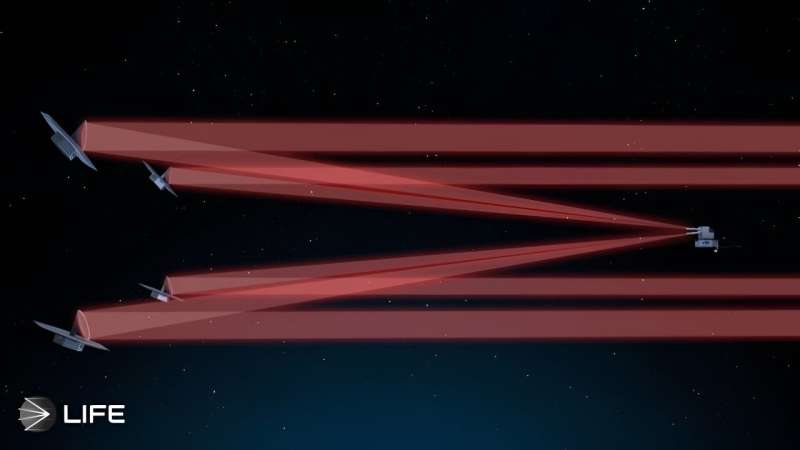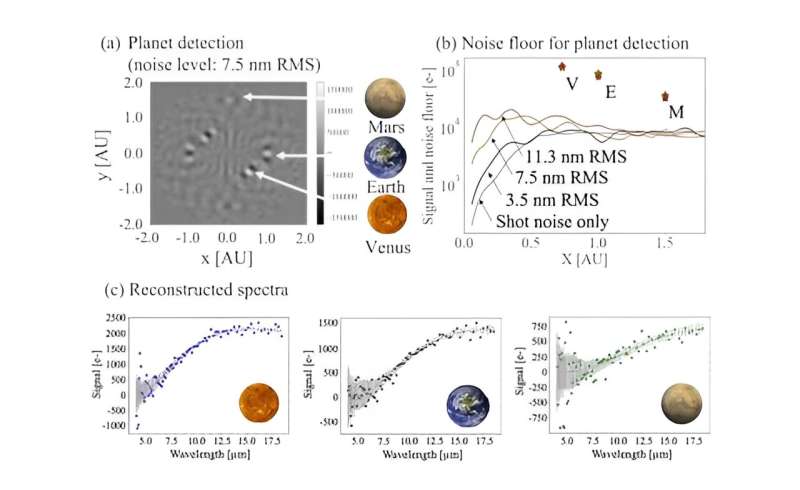This article has been reviewed according to Science X's editorial process and policies. Editors have highlighted the following attributes while ensuring the content's credibility:
fact-checked
preprint
trusted source
proofread
The next generation LIFE telescope could detect some intriguing biosignatures

The Large Interferometer for Exoplanets (LIFE) project is an ambitious plan to build a space telescope with four independent mirrors. The array would allow the individual mirrors to move closer or farther apart, similar to the way the Very Large Array (VLA) does with radio antennas.
LIFE is still early in its planning stage, so it would likely be decades before it is built, but already the LIFE team is looking at ways it might discover life on other worlds. Much of this focuses on the detection of biogenic molecules in exoplanet atmospheres.
Earlier studies looked at simulations of how our solar system would appear as an exoplanetary system. If aliens used LIFE to view our solar system from 10 parsecs away (about 32 light-years), then the array would be able to directly observe Venus, Earth, and Mars. Using a process known as phase-space synthesis decomposition (PSSD), LIFE would also be able to detect several basic molecules in their atmospheres such as water and carbon dioxide.
Of course, lots of potentially habitable worlds are expected to have atmospheric quantities of these molecules, but that doesn't necessarily indicate the presence of life. A stronger case for life would be made if astronomers could detect more complex molecules that are biogenic in origin, meaning that they aren't likely to form through any geological process.
This new study focuses on three types of molecules: nitrous oxide (N2O), also known as laughing gas, methyl chloride (CH3Cl), and methyl bromide (CH3Br). All three of these are produced by ocean biology on Earth, so their presence in an exoplanet atmosphere would be a reasonable indication of life. Details have been published on the pre-print server arXiv.

Based on their simulations, the authors argue that LIFE would be able to detect these molecules in atmospheric atmospheres for worlds within 5 parsecs of Earth, and should be able to gather sufficient data within 10–100 days of observation time. A nearby system such as Proxima Centauri, just 4 light-years from Earth would take only a few days of observation. But even for a more distant system such as Trappist-1, which is 40 light-years away, LIFE has a decent chance of detection given enough time.
The Large Interferometer for Exoplanets is currently one project being considered by the European Space Agency, but there are other life-seeking projects being proposed as well.
It will be years before LIFE or another mission will be approved, and a decade or more after that before it is launched. But studies such as these are needed to make those decisions. The search is on, and finding exoplanet life could be just a matter of time.
More information: Taro Matsuo et al, Large Interferometer For Exoplanets (LIFE): XI. Phase-space synthesis decomposition for planet detection and characterization, arXiv (2023). DOI: 10.48550/arxiv.2308.01478
Daniel Angerhausen et al, Large Interferometer For Exoplanets (LIFE): XII. The Detectability of Capstone Biosignatures in the Mid-Infrared—Sniffing Exoplanetary Laughing Gas and Methylated Halogens, arXiv (2024). DOI: 10.48550/arxiv.2401.08492
Journal information: arXiv
Provided by Universe Today





















